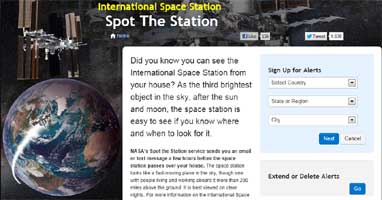 As we celebrate 12 years of continuous human habitation of the International Space Station (ISS), NASA is making it easier for the average person to find the space station in the sky. If you have never seen it, seeing the ISS as the space station soars across the night sky, it is worth the time. However, with the ISS moving at over 17,000 miles per hour, giving you only minutes to see the station streak overhead like a shooting star, knowing where and when to look to see the space station is very important.
As we celebrate 12 years of continuous human habitation of the International Space Station (ISS), NASA is making it easier for the average person to find the space station in the sky. If you have never seen it, seeing the ISS as the space station soars across the night sky, it is worth the time. However, with the ISS moving at over 17,000 miles per hour, giving you only minutes to see the station streak overhead like a shooting star, knowing where and when to look to see the space station is very important.
To make the task of finding the international space station in the sky easier, NASA announced last week a new service to help people see the orbiting laboratory when it passes overhead. The free online tool from NASA called “Spot the Station” will send an email or text message to those who sign up for the service a few hours before they will be able to see the space station.
“It’s really remarkable to see the space station fly overhead and to realize humans built an orbital complex that can be spotted from Earth by almost anyone looking up at just the right moment,” said William Gerstenmaier, NASA’s associate administrator for human exploration and operations. “We’re accomplishing science on the space station that is helping to improve life on Earth and paving the way for future exploration of deep space.”
So when is the space station typically visible? The answer is typically at dawn and dusk. This timing allows for the sun, just below the horizon, to illuminate the space station in its orbit above the earth without fully lighting up the sky itself. The higher the orbit of the ISS above the horizon, the longer the appearance and the darker the sky can be as it transits visibly.
So what does the international space station (ISS) look like in the sky? The ISS will be the brightest object in the night sky, and on a clear night, the station is visible as a fast moving point of light, similar in size and brightness to the planet Venus.
When signing up for the free “Spot the Station” online tool, users have the option to receive alerts about morning, evening or both types of sightings. What’s more, the service is designed to only notify users of passes that are high enough in the sky to be easily visible over trees, buildings and other objects on the horizon.
To register for “Spot the Station” simply visit the NASA web site at: http://spotthestation.nasa.gov/
![Herbal Reference Substances are Key to Everyday Products <!-- AddThis Sharing Buttons above -->
<div class="addthis_toolbox addthis_default_style " addthis:url='http://newstaar.com/herbal-reference-substances-are-key-to-everyday-products/3512112/' >
<a class="addthis_button_facebook_like" fb:like:layout="button_count"></a>
<a class="addthis_button_tweet"></a>
<a class="addthis_button_pinterest_pinit"></a>
<a class="addthis_counter addthis_pill_style"></a>
</div>When it comes to quality control testing and the development of new products, Botanical Reference Materials (BRMs), also known as Herbal References are critically important. To help companies ultimately obtain all-important FDA approval, the Food and Drug Administration provides in its guidance a recommendation that […]<!-- AddThis Sharing Buttons below -->
<div class="addthis_toolbox addthis_default_style addthis_32x32_style" addthis:url='http://newstaar.com/herbal-reference-substances-are-key-to-everyday-products/3512112/' >
<a class="addthis_button_preferred_1"></a>
<a class="addthis_button_preferred_2"></a>
<a class="addthis_button_preferred_3"></a>
<a class="addthis_button_preferred_4"></a>
<a class="addthis_button_compact"></a>
<a class="addthis_counter addthis_bubble_style"></a>
</div>](http://newstaar.com/wp-content/uploads/2021/02/Achillea_millefolium_flowers-100x100.jpg)
![Quality Electrochemical Biosensors are Critical for Medical, Food and Chemical Industry <!-- AddThis Sharing Buttons above -->
<div class="addthis_toolbox addthis_default_style " addthis:url='http://newstaar.com/quality-electrochemical-biosensors-are-critical-for-medical-food-and-chemical-industry/3512086/' >
<a class="addthis_button_facebook_like" fb:like:layout="button_count"></a>
<a class="addthis_button_tweet"></a>
<a class="addthis_button_pinterest_pinit"></a>
<a class="addthis_counter addthis_pill_style"></a>
</div>A number of industries have, at their core, a need to frequent or even continuous analysis of biological media. These include the medical and pharmaceutical fields, biotech firms, and food and chemical companies. To maintain quality standards and develop new products, these industries rely heavily […]<!-- AddThis Sharing Buttons below -->
<div class="addthis_toolbox addthis_default_style addthis_32x32_style" addthis:url='http://newstaar.com/quality-electrochemical-biosensors-are-critical-for-medical-food-and-chemical-industry/3512086/' >
<a class="addthis_button_preferred_1"></a>
<a class="addthis_button_preferred_2"></a>
<a class="addthis_button_preferred_3"></a>
<a class="addthis_button_preferred_4"></a>
<a class="addthis_button_compact"></a>
<a class="addthis_counter addthis_bubble_style"></a>
</div>](http://newstaar.com/wp-content/uploads/2020/10/Electrochemical-Biosensor-100x100.jpg)
![Company Develops Industrial Mixers Well-Suited for both Fragile and Explosive Products <!-- AddThis Sharing Buttons above -->
<div class="addthis_toolbox addthis_default_style " addthis:url='http://newstaar.com/company-develops-industrial-mixers-well-suited-for-both-fragile-and-explosive-products/3512071/' >
<a class="addthis_button_facebook_like" fb:like:layout="button_count"></a>
<a class="addthis_button_tweet"></a>
<a class="addthis_button_pinterest_pinit"></a>
<a class="addthis_counter addthis_pill_style"></a>
</div>Industrial drum mixers are normally applied to blend mixes of varying viscosities such as adhesive slurries or cement. Some of these mixers have the capability of blending mixes of very different particle sizes such as fruit and ice cream, and gravel and cement slurry. The […]<!-- AddThis Sharing Buttons below -->
<div class="addthis_toolbox addthis_default_style addthis_32x32_style" addthis:url='http://newstaar.com/company-develops-industrial-mixers-well-suited-for-both-fragile-and-explosive-products/3512071/' >
<a class="addthis_button_preferred_1"></a>
<a class="addthis_button_preferred_2"></a>
<a class="addthis_button_preferred_3"></a>
<a class="addthis_button_preferred_4"></a>
<a class="addthis_button_compact"></a>
<a class="addthis_counter addthis_bubble_style"></a>
</div>](http://newstaar.com/wp-content/uploads/2020/06/bandeau-sofragir2-100x100.jpg)